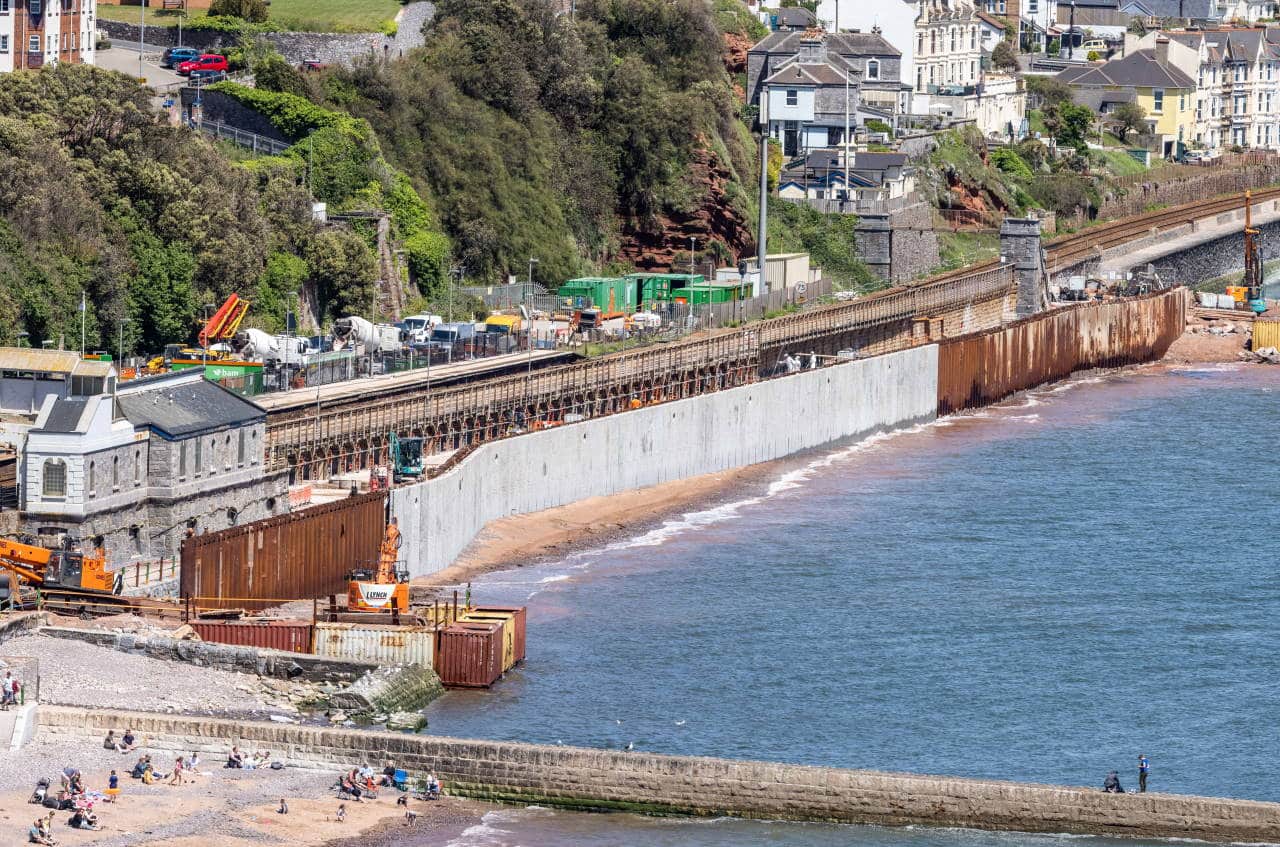Network Rail is taking advantage of the latest in carbon-cutting construction technology by using low carbon concrete to reinforce the new bigger sea wall at Dawlish.
In February 2014 a devastating storm destroyed the coastline at Dawlish, cutting off the only rail connection to the southwest and leading to an 8-week closure of the line.
Network Rail‘s Coastal Protection Scheme commits to improve the resilience of the railway, protect rail services and keep the community moving for the next 100 years.
Using the latest technology will ensure that this happens efficiently whilst also working towards cutting global carbon emissions worldwide.
The innovative new concrete ‘Hanson’s low carbon Regen GGBS concrete’ is created by using a by-product of the steel manufacturing process and this substance replaces a large amount of the cement that would normally be used to build a structure.
Traditional concrete accounts for 7% of global carbon emissions throughout the world and 1.5% of this is from the UK due to the energy-intensive process required to make cement.
The project will use massive amounts of concrete and it is expected that the use of the new low carbon concrete will have cut carbon levels by an impressive two-thirds which is great news for the projects carbon footprint.
The construction of the seawall is moving along well since work started in November 2020. Piling has been successfully installed by BAM Nuttall and 126 of 143 concrete wall panels having already been installed.
The second section of the sea wall is expected to take 2 years to complete linking up the sea wall from Coastguard breakwater east to Marine Parade.
Julie Gregory, Network Rail senior sponsor, said: “The nature of our changing climate means that the south Devon coast is increasingly subject to powerful storms. To protect the railway at Dawlish we need to build a robust sea wall that can withstand the worst weather that the English Channel can throw at it.
“It was important that we carefully considered how the project can limit its carbon footprint and reduce the chances of it contributing to further climate change, and we are delighted how BAM Nuttall are helping us achieve this by delivering this low carbon alternative to traditional concrete.”
Jack Brookes, site agent, BAM Nuttall, said: “From the earliest phase of this project, we have considered how this scheme can limit its environmental impact without compromising the strength and resilience of the structure. The final design uses piles buried deep in the bedrock to create stability for the structure. Those piles are protected by prefabricated facing panels created off-site and reinforced by concrete poured in behind the visible section of wall.
“We identified Hanson’s low carbon concrete as an innovative product that could help us to reduce our carbon impact by two-thirds while retaining the strength of traditional concrete. We worked closely with Network Rail to ensure that the material is approved for use on Britain’s Railway and look forward to seeing it being used in more major civil engineering schemes.”
David Cullimore, area general manager for Hanson Concrete, said: “We have worked closely with BAM Nuttall to design a pumpable low carbon concrete which contained lower quantities of cement to help improve sustainability credentials while maintaining durability in aggressive conditions.
“The production of cement requires limestone to be heated to over 1,450 degrees Celsius, which makes it energy intensive to produce and creates carbon dioxide as a result of the production process. The low carbon concrete solutions on this job contain high levels of Regen GGBS (ground granulated blast furnace slag), a by-product of steel making, as a replacement for some of the cement content, which reduces the CO2 emissions associated with the concrete.
“Working in partnership with BAM and Network Rail, we frequently overcame difficult logistical, technical and operational challenges created by pouring large amounts of high specification concrete up to 200 metres through the night in very short tidal windows.”
Where Next?
RAILADVENT NEWS
The latest railway news
RailAdvent Plus
Discounts, videos, pictures and more!
FREE NEWSLETTERS
Signup to our daily and weekly newsletters
RAILADVENT SHOP
Railway Prints, DVD’s / Blu-Ray’s, books and more
LOCOSTOP COMMUNITY
Come and share your railway pictures
UK STEAM INFO
Upcoming mainline steam tours/loco movements
NETWORK RAIL
Visit their website






Responses
The Title given to this piece is just totally misleading and factually untrue .
There has been no change in the smelting process by Hanson or anyone else of steel and the by product of “marine cement” from the slag has not changed .
Bulk lorries have been running around Motorways for as long as I can remember with “Marine Slag Cement ” plastered all over them . It comes from Port Talbot Red Dragon , mainly because thats the only blast furnaces left in the UK !!!!
In the 1930s the old Great Western railway bought the land for an inland route from Starcross to Newton Abbot (Bishopsteignton). Along came WW2 and nationalisation and nothing happened. The land was sold off in the 1950s.